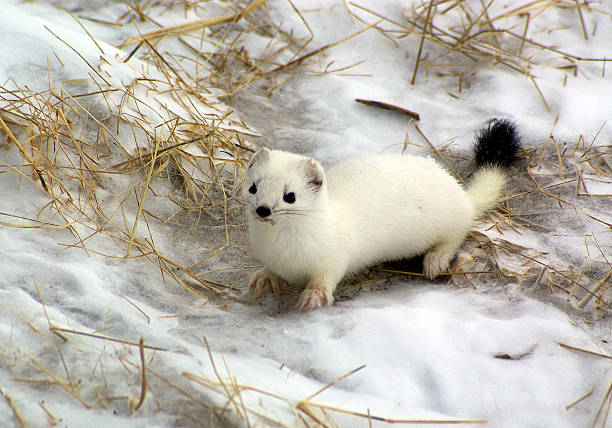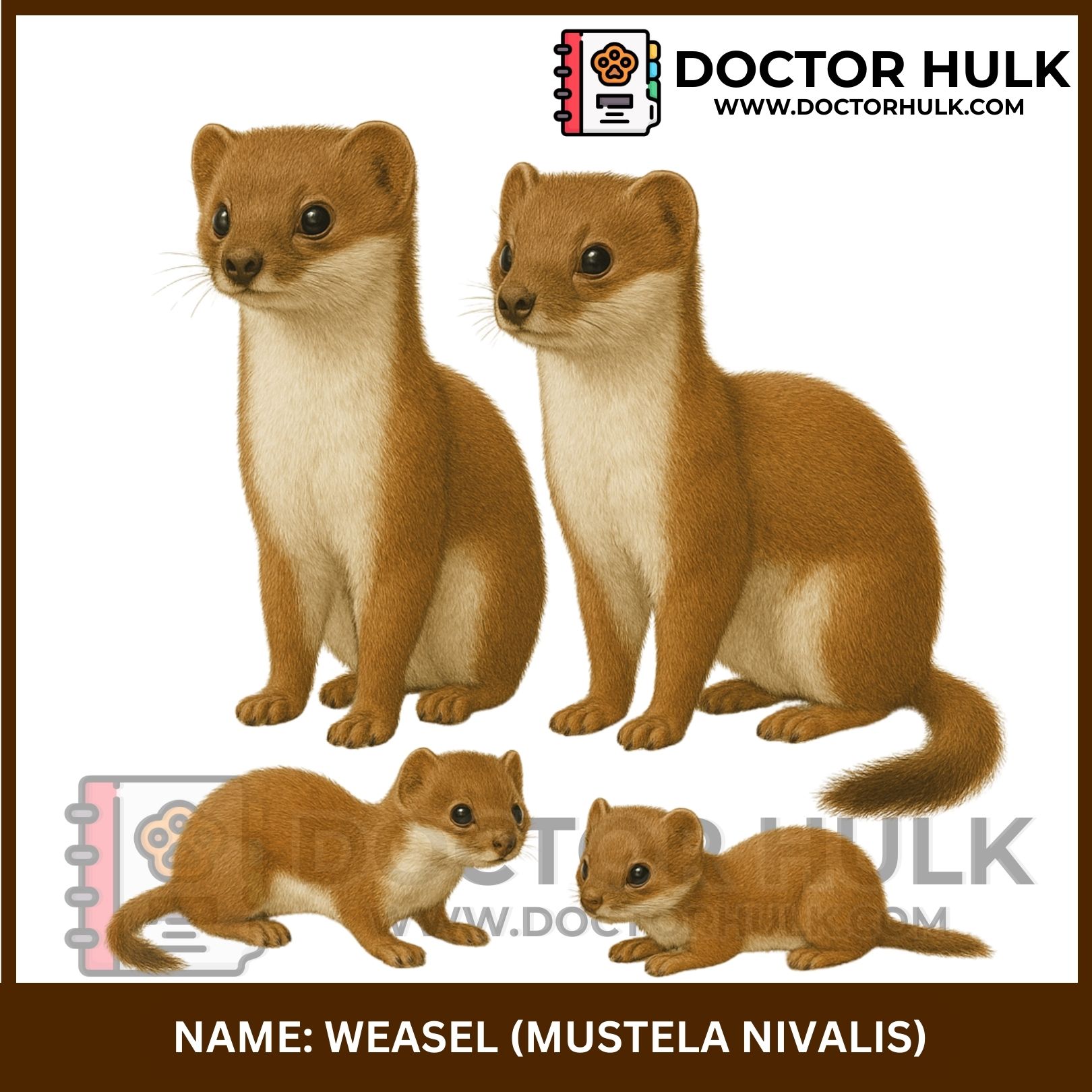A weasel is a small, slender carnivorous mammal known for its agility and quick movements. They have long, narrow bodies, short legs, and a triangular-shaped head with sharp, pointed ears. Their fur is typically brown or reddish-brown on the back, with a lighter-colored belly, although some species turn white in winter to blend in with snow. Weasels are often mistaken for ferrets, but they are smaller and have a more elongated shape.
These little predators are fast and energetic, capable of squeezing into tight spaces to chase down their prey, which mainly includes small mammals like mice, rabbits, and birds. They are expert hunters, using their sharp teeth and keen senses to catch and kill prey. Weasels are known for their ability to hunt much larger animals than you might expect for their size, sometimes taking down creatures many times their own weight.
Scientific Classification
-
Kingdom: Animalia
-
Phylum: Chordata
-
Class: Mammalia
-
Order: Carnivora
-
Family: Mustelidae
-
Genus: Mustela
-
Species: Multiple species including:
-
Mustela nivalis (Least weasel)
-
Mustela frenata (Long-tailed weasel)
-
Mustela erminea (Stoat or ermine)
-
Weasels are part of the mustelid family, which includes otters, martens, ferrets, badgers, and wolverines.
Common Names
-
English: Weasel
-
Yoruba: Ẹranko aláyàlà (small clever animal)
-
Igbo: Nkpuru mmiri (forest animal, uncommon)
-
Hausa: Beran daji (wild rodent-like hunter)
-
French: Belette
-
Local Nicknames: Grassland thief, Mouse chaser
Geographic Distribution
Weasels are found on every continent except Australia and Antarctica, including:
-
North America
-
Europe
-
Asia
-
Northern Africa
They live in:
-
Forests
-
Grasslands
-
Farmlands
-
Marshy areas
-
Even near villages (but rarely seen)
Physical Characteristics
-
Body: Long, slim, and flexible
-
Size:
-
Least weasel: 15–20 cm (smallest carnivore in the world!)
-
Long-tailed weasel: 25–35 cm
-
-
Tail: Short to long depending on species
-
Coat: Brown above, white or yellowish below
-
Winter Coat: In cold climates, turns pure white (called ermine) for camouflage
 Image showing a white winter weasel peeking from snow with black-tipped tail (Source: iStock)
Image showing a white winter weasel peeking from snow with black-tipped tail (Source: iStock)
Adaptations & Behavior
-
Shape: Their narrow body lets them chase prey into burrows and holes
-
Speed: Quick reflexes and lightning-fast strikes
-
Agility: Can twist, climb, and leap with ease
-
Solitary: Weasels are shy, secretive, and usually hunt alone
-
Territorial: They mark their home range with scent glands
Diet
Weasels are carnivores, eating mostly:
-
Mice and rats
-
Rabbits and voles
-
Birds and eggs
-
Frogs, insects, and small reptiles
They eat often and can consume prey half their own body weight daily.
Types of Weasels (Species)
1. Least Weasel (Mustela nivalis)
-
World’s smallest carnivorous mammal
-
Found in Europe, Asia, North Africa
-
Brown and white coat; white all over in winter
 Image showing a tiny least weasel holding a mouse in its jaws on a tree branch (Source:Robert E fuller)
Image showing a tiny least weasel holding a mouse in its jaws on a tree branch (Source:Robert E fuller)
2. Long-Tailed Weasel (Mustela frenata)
-
Native to North and Central America
-
Long tail with black tip, more aggressive than other weasels
-
Known for bold behavior and excellent tree-climbing

3. Stoat / Ermine (Mustela erminea)
-
Found in Europe, Asia, and North America
-
Changes to white coat in winter with black tail tip
-
Featured in royal fur robes in medieval Europe
 Image showing a stoat in snow with only its nose and black tail tip visible (Source: Pinterest)
Image showing a stoat in snow with only its nose and black tail tip visible (Source: Pinterest)
Reproduction & Family Life
-
Mating season: Spring or summer
-
Delayed implantation in some species (baby develops later)
-
Gestation: 30–60 days (longer if delayed)
-
Litter size: 4–12 kits
-
Young born blind and helpless, fully weaned by 5–8 weeks
-
The mother raises them alone, teaching them to hunt
Predators & Dangers
Weasels are preyed upon by:
-
Foxes
-
Owls
-
Hawks
-
Snakes
-
Larger carnivores
Other threats include:
-
Habitat loss
-
Rodenticides (they eat poisoned rodents and get sick)
-
Human fear or hunting due to superstition
Conservation Status
Most weasel species are listed as Least Concern, but their numbers are decreasing in some areas due to:
-
Pesticide use
-
Farming changes
-
Loss of hedgerows and wild spaces
Some subspecies, like the mountain weasel, are more threatened and need habitat protection.
Fun facts about Weasels
-
Weasels perform a strange dance called the “weasel war dance” when excited
-
The word weasel is sometimes used for someone sneaky — unfairly.
-
They’re silent hunters, sneaking up on prey before pouncing
-
Ancient Egyptians admired weasels for controlling pests
-
In some cultures, weasels are symbols of cleverness and stealth
Weasel vs Ferret
| Feature | Weasel | Ferret |
|---|---|---|
| Wild or Domesticated | Wild | Domesticated (pet/hunting) |
| Size | Smaller, slender | Longer body, slightly heavier |
| Coat | Brown or white (seasonal) | Usually pale or mixed coat |
| Use | Pest control in wild | Hunting, pets |
| Behavior | Solitary, wild hunter | Playful, social in captivity |
For wildlife rescue, animal care education, or small mammal advice, you can reach out to us at Doctor Hulk Veterinary Hospital, or call us through 08143397614.













Reviews
There are no reviews yet.